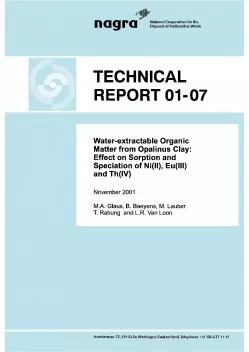
Technical Report NTB 01-07
Water-extractable Organic Matter from Opalinus Clay: Effect on Sorption and Speciation of Ni(II), Eu(III) and Th(IV)
The purpose of the present study is to characterise water-extractable organic matter from Opalinus clay (OPA) with respect to possible complexing properties. OPA samples obtained from the Mont Terri rock laboratory and from the Benken site were used. The effect of organic matter extracted from these samples on the sorption of Ni(II), Eu(lIl) and Th(IV), representing bi-to tetravalent elements, on a commercial cation exchange resin was studied at pH ~8. The solid-liquid distribution coefficients were compared to those measured for synthetic waters, which are similar in composition to the aqueous extracts, but contain no organic matter. Within the range of estimated uncertainties, no difference in sorption is observed for most of cases. Only for a few extracts, slight reduction of sorption (less than a factor of 5) of Eu(lll) and Ni(lI) is found. Test experiments using small-molecular weight ligands and Aldrich humic acid show that the sensitivity of the ion exchange method is adequate at the specific conditions of the OPA extracts. The results of accompanying fluorescent spectroscopy experiments do not show any influence of the extracts on Cm(lll) speciation, which is dominated by carbonate complexes. This suggests that the reduction of sorption partly observed in the ion exchange experiments is not caused by the formation of complexes between the radionuclides and the organic matter in the extracts, but rather due to a possible underestimation of minor systematic uncertainties, such as unknown differences in the chemical composition between the extracts and the synthetic waters.
From these findings and from UV-VIS spectroscopic characterisation of the organic matter in the extracts, it can be concluded that only a small fraction of the organic matter may be present as humic or fulvic acids. The largest part of the organic matter are most probably either small-molecular weight molecules or macromolecules with a very low content in ligand sites.
The OPA samples tested are representative for the different facies in the OPA formations of Mont Terri and Benken. Therefore, the conclusions drawn for the influence of water-extractable organic matter on the sorption and speciation of radionuclides can safely be applied to any location within the OPA formation at Benken. The similarity of OPA formations at Mont Terri and Benken with respect to chemical behaviour is once more corroborated by this study. The latter location is considered as a potential site for the disposal of high-level and long-lived intermediate-level radioactive waste in Switzerland.
